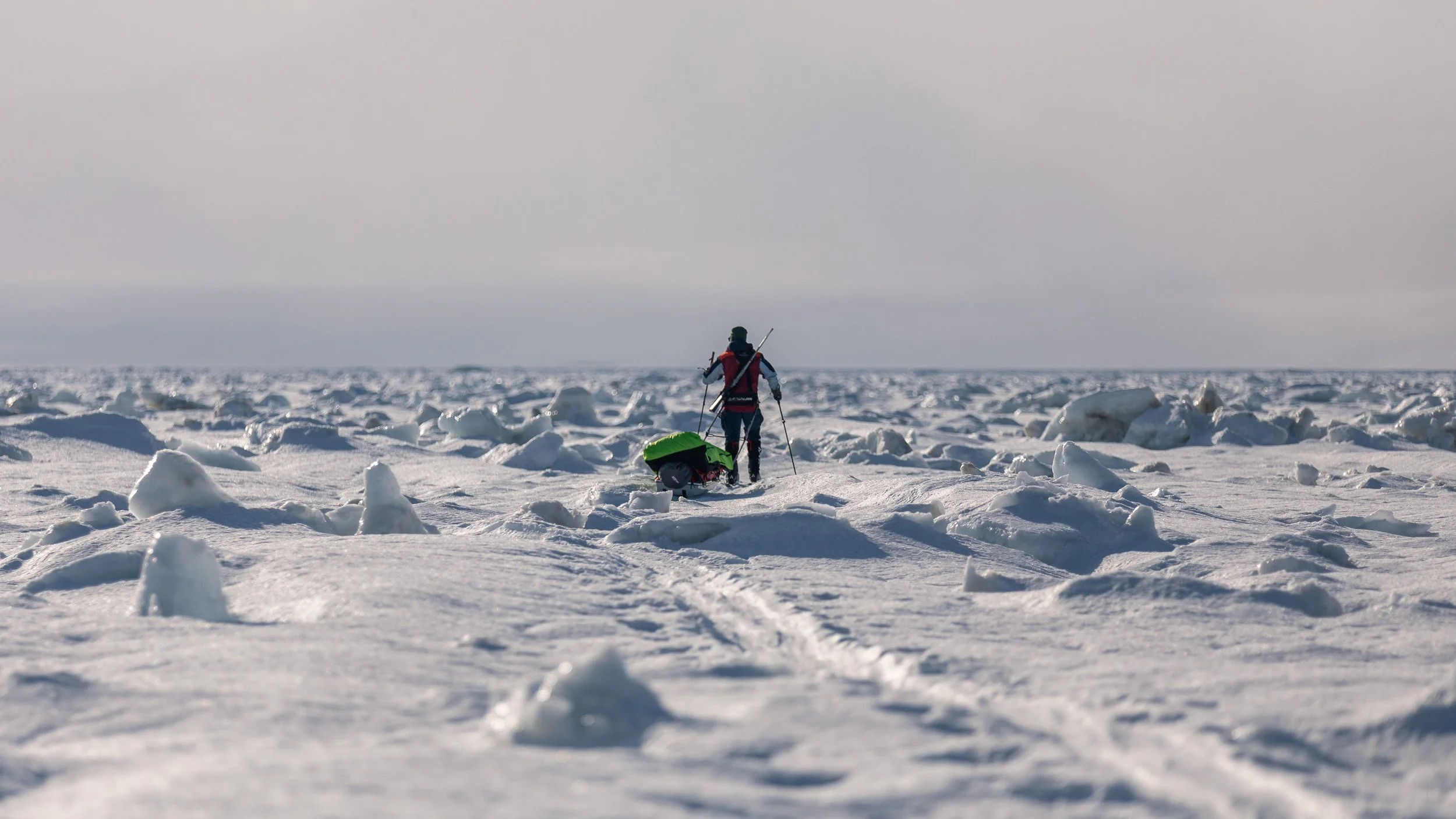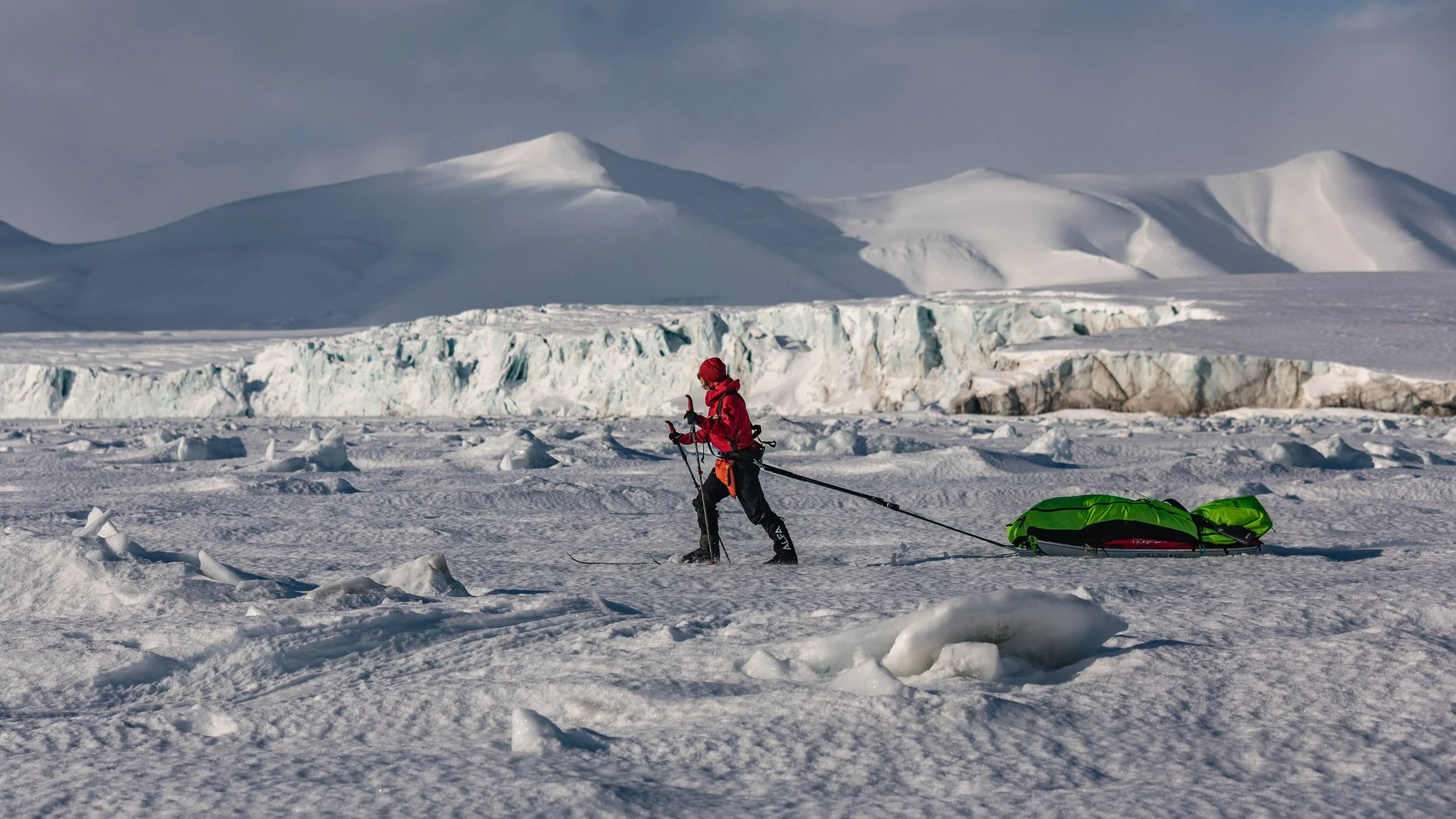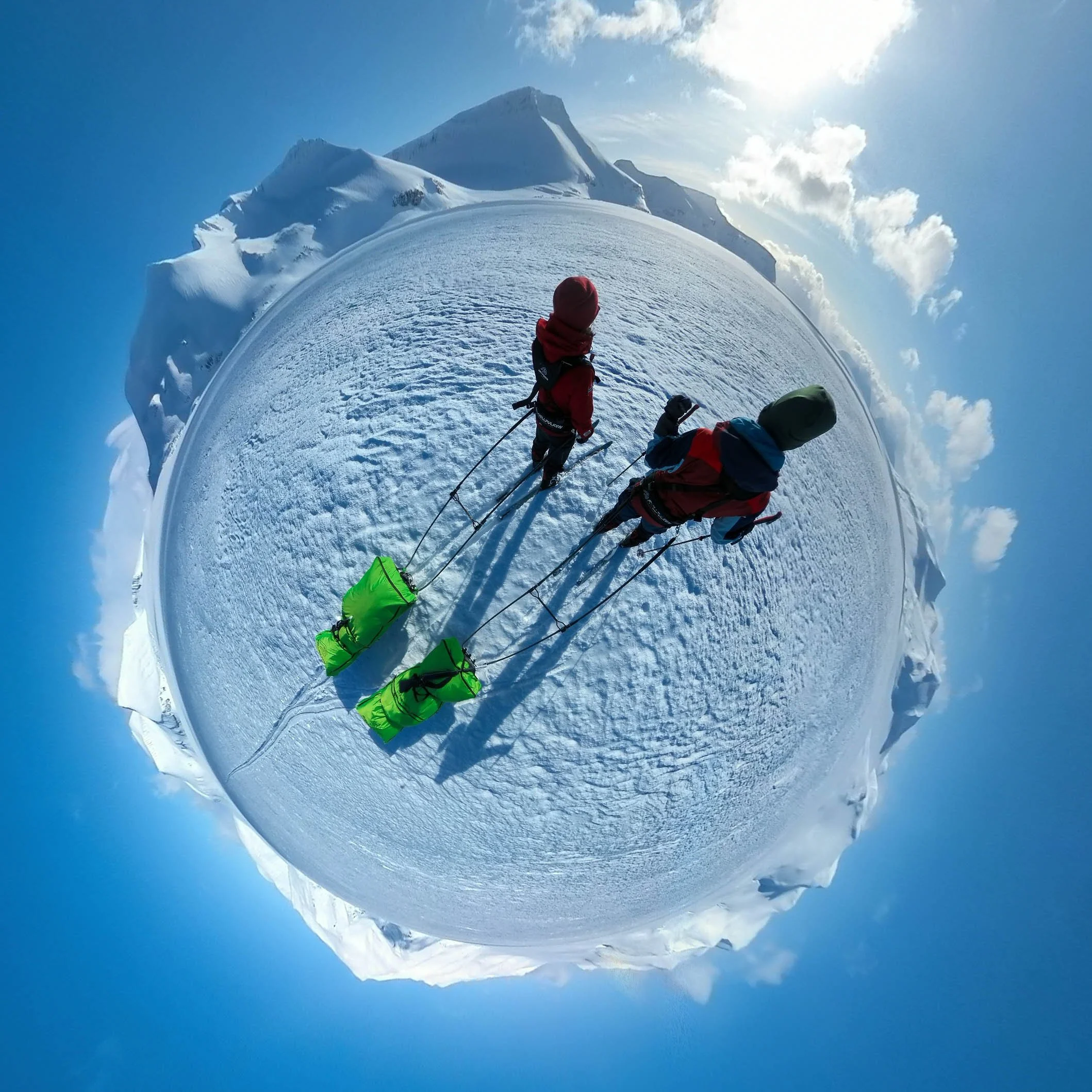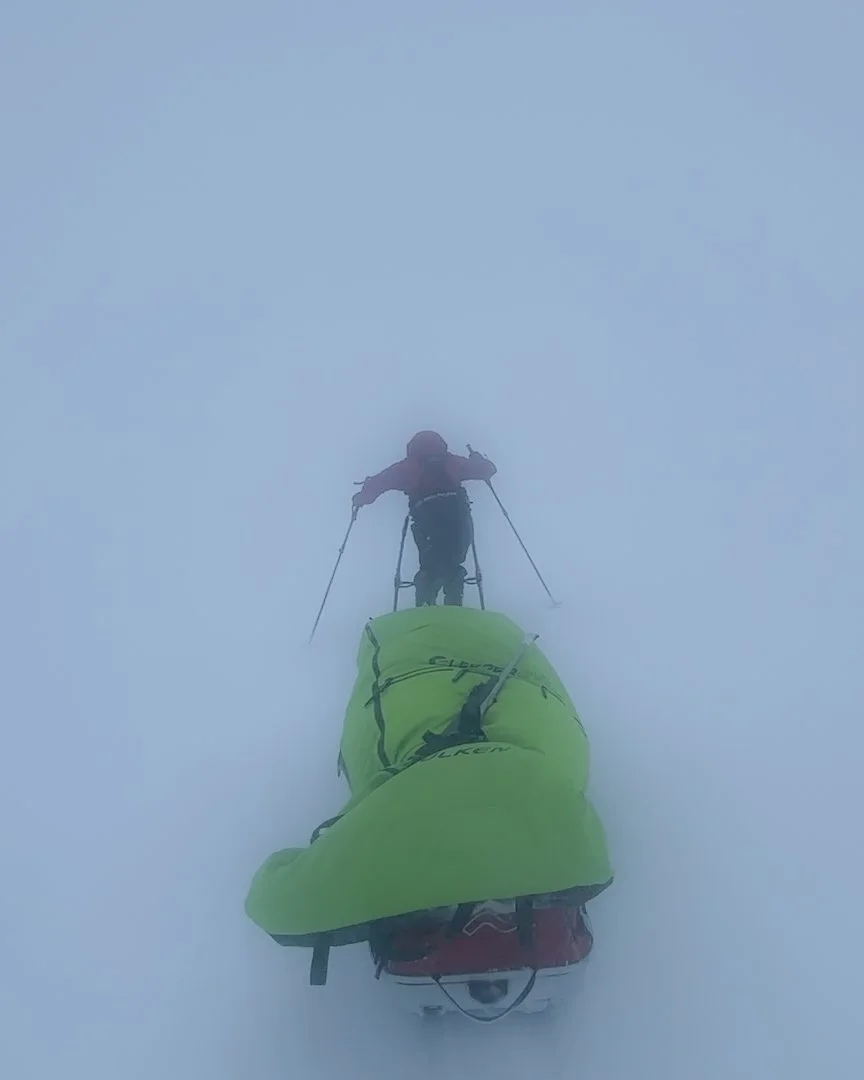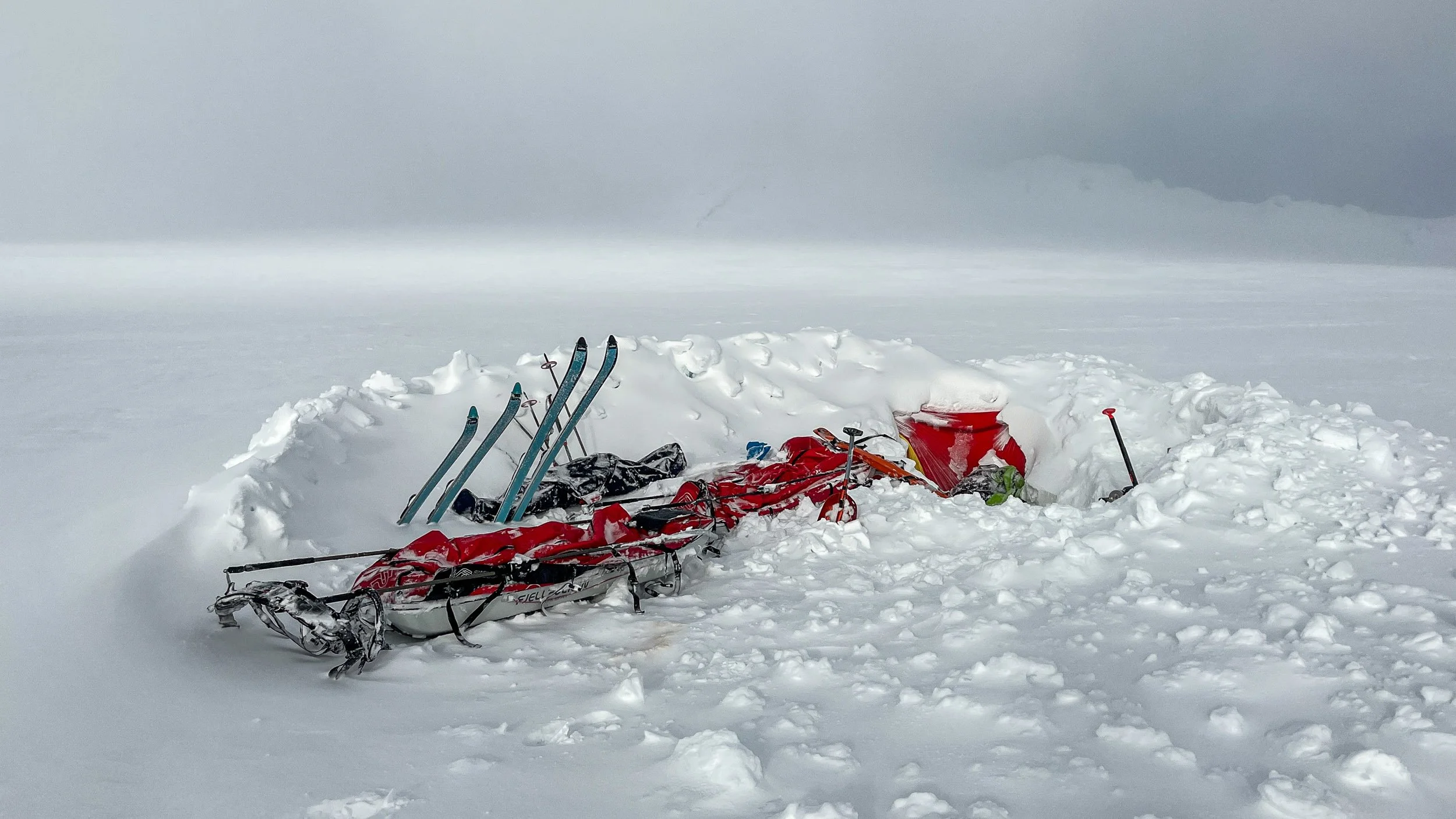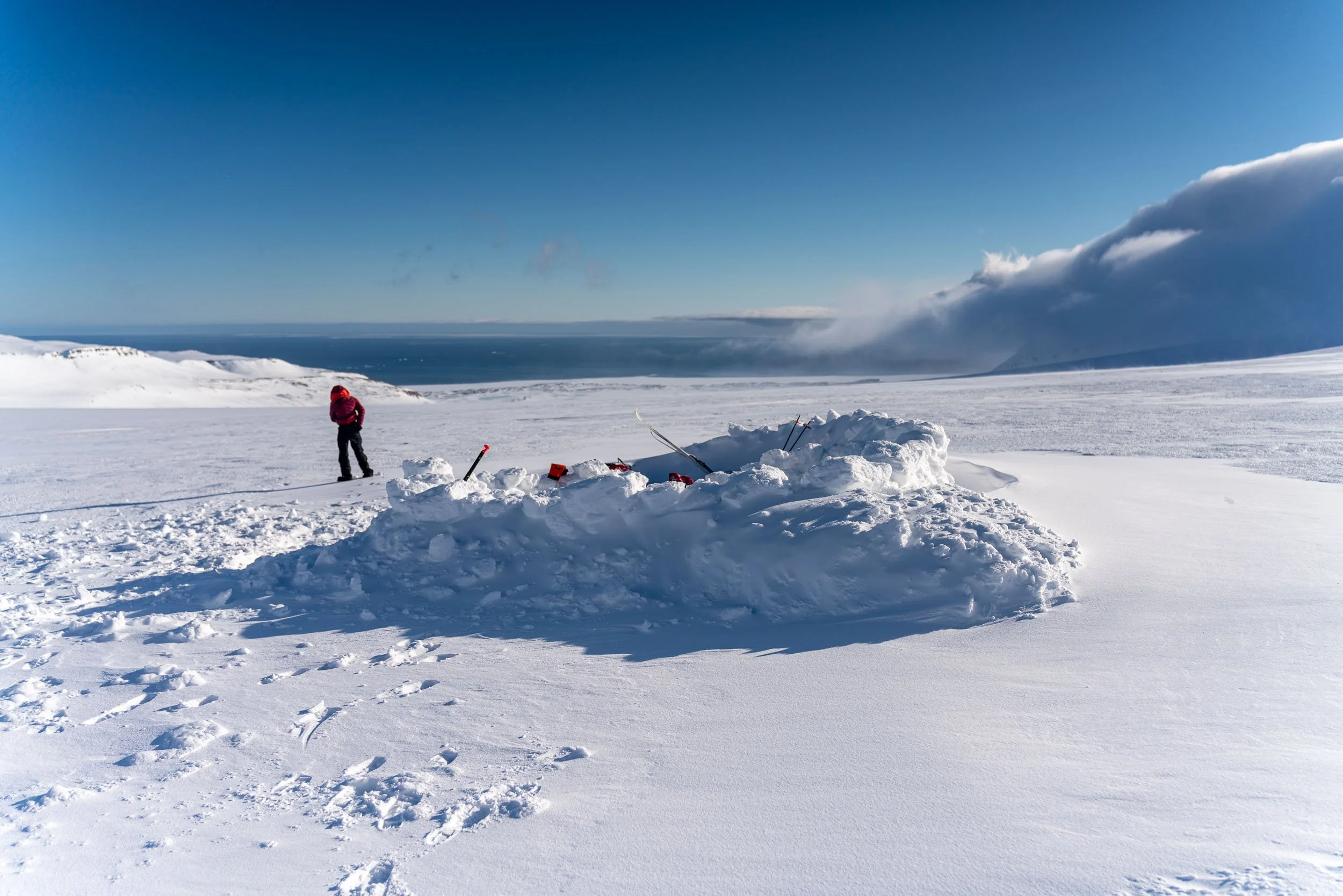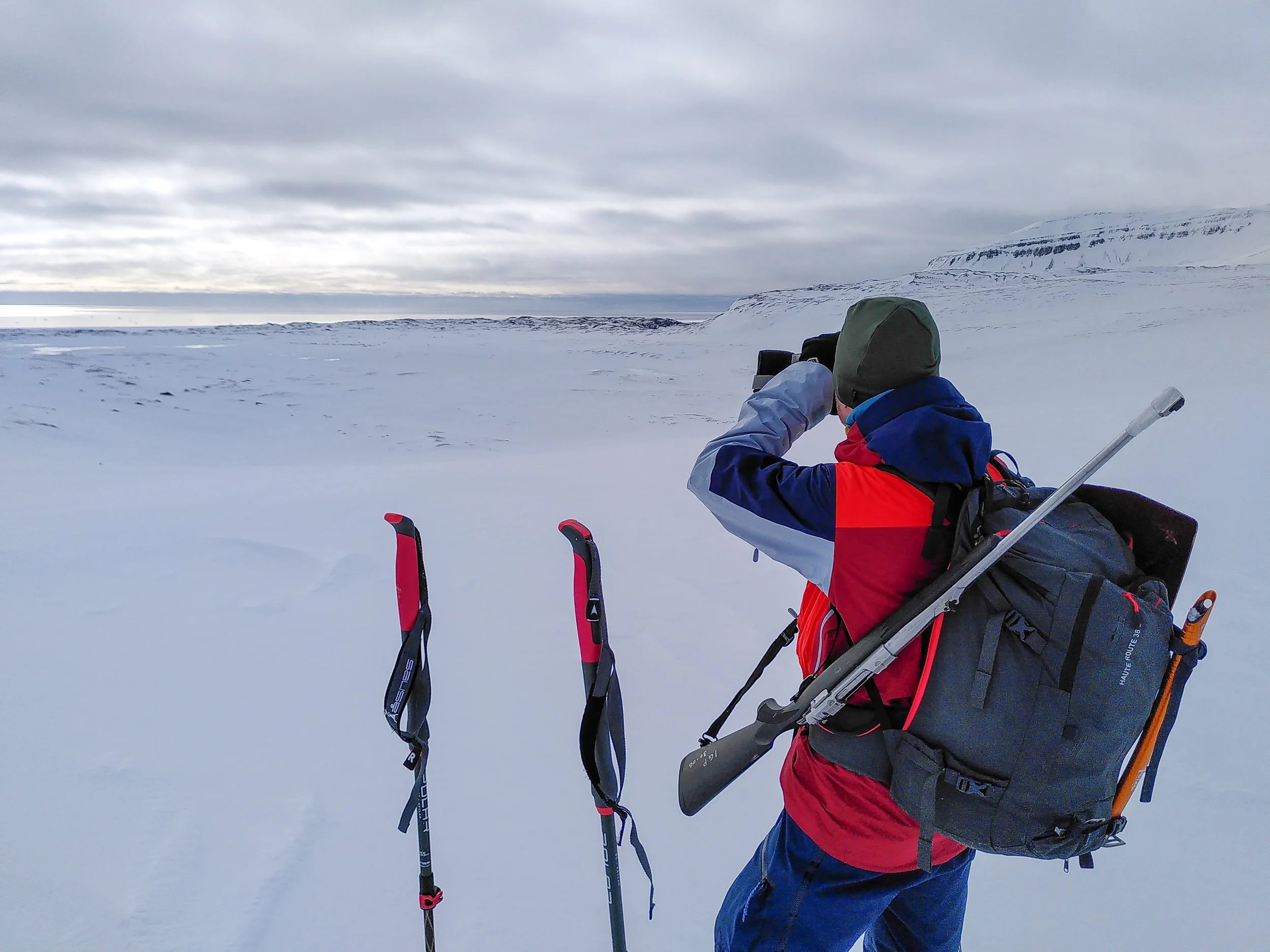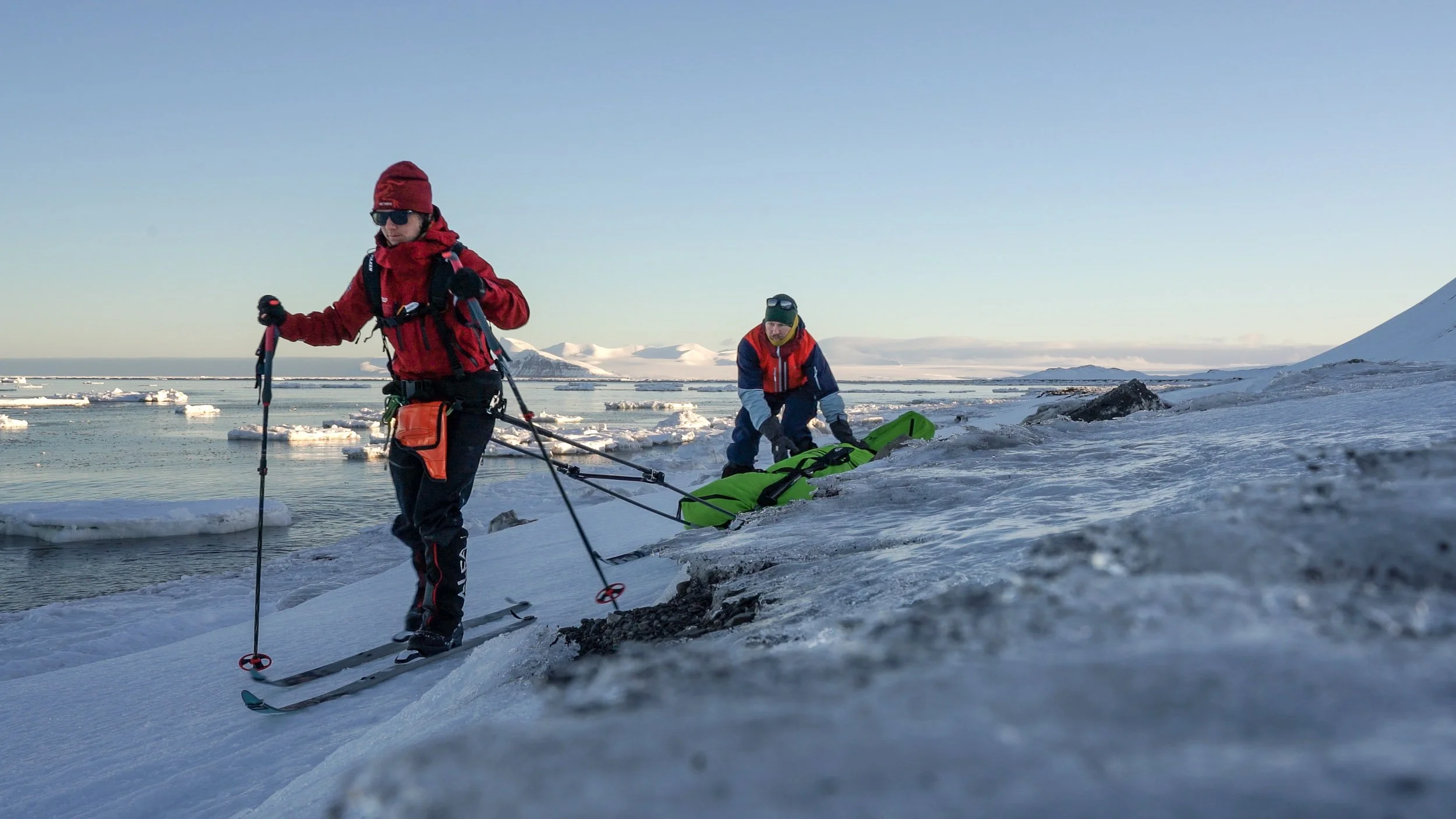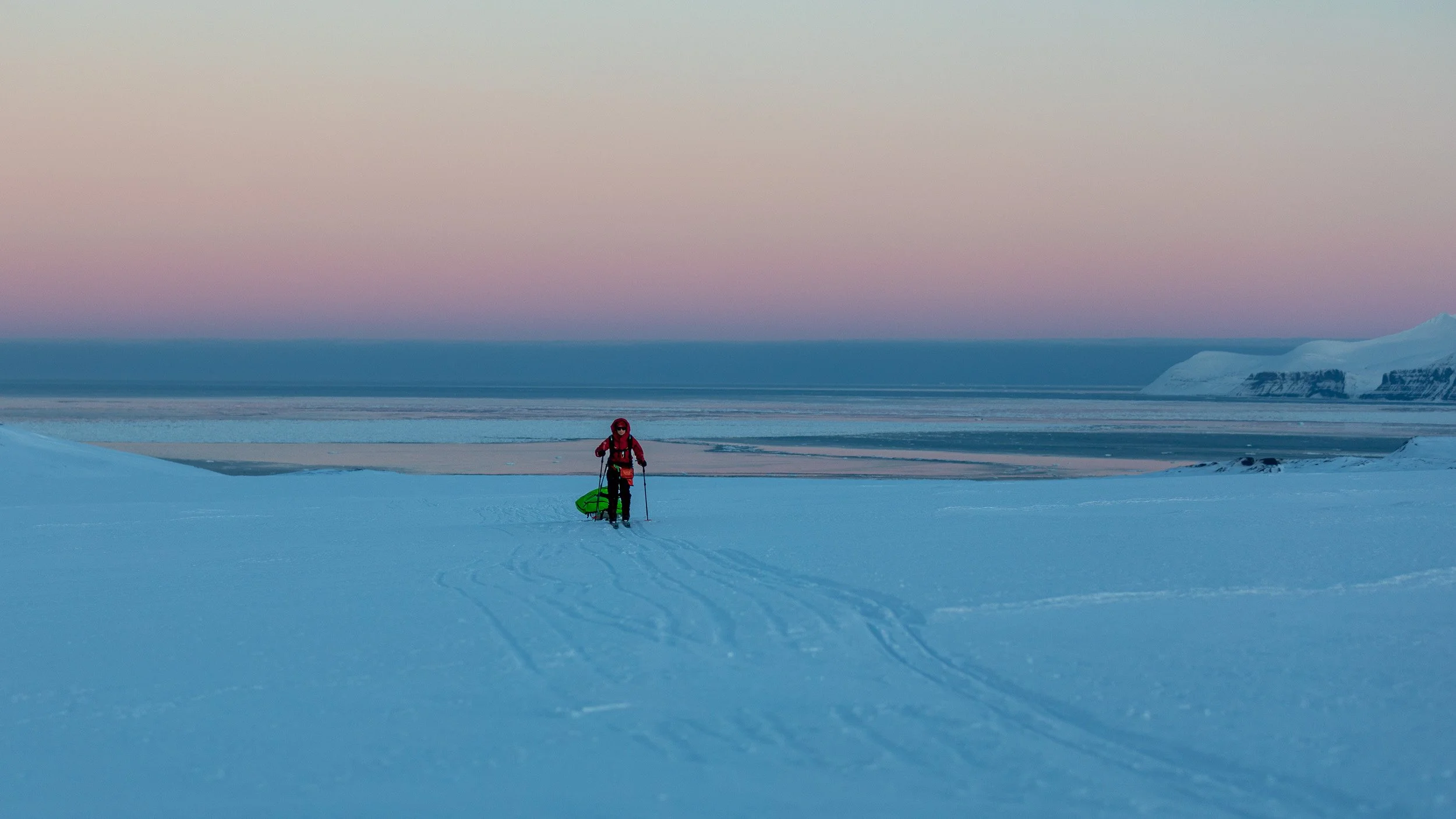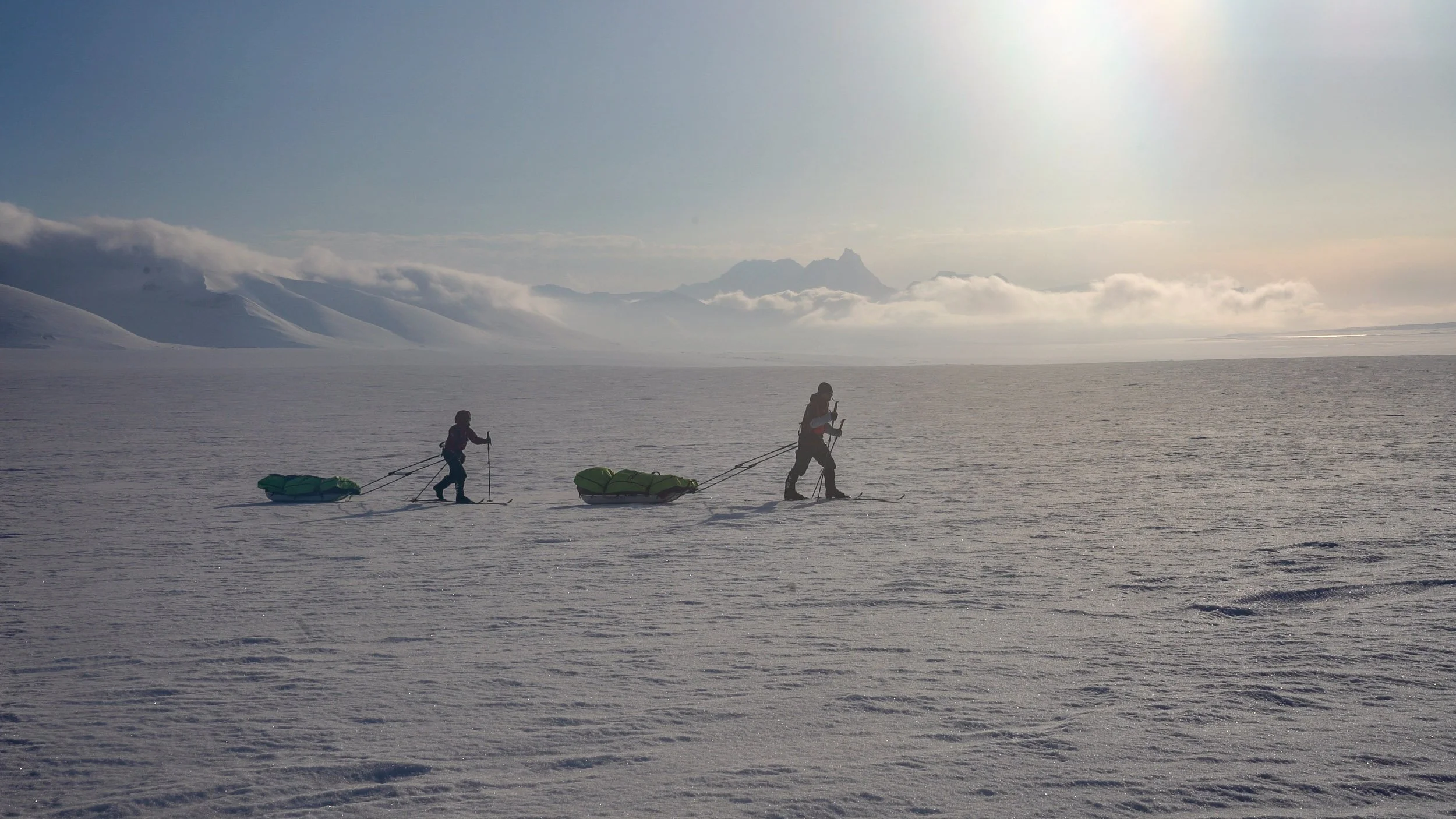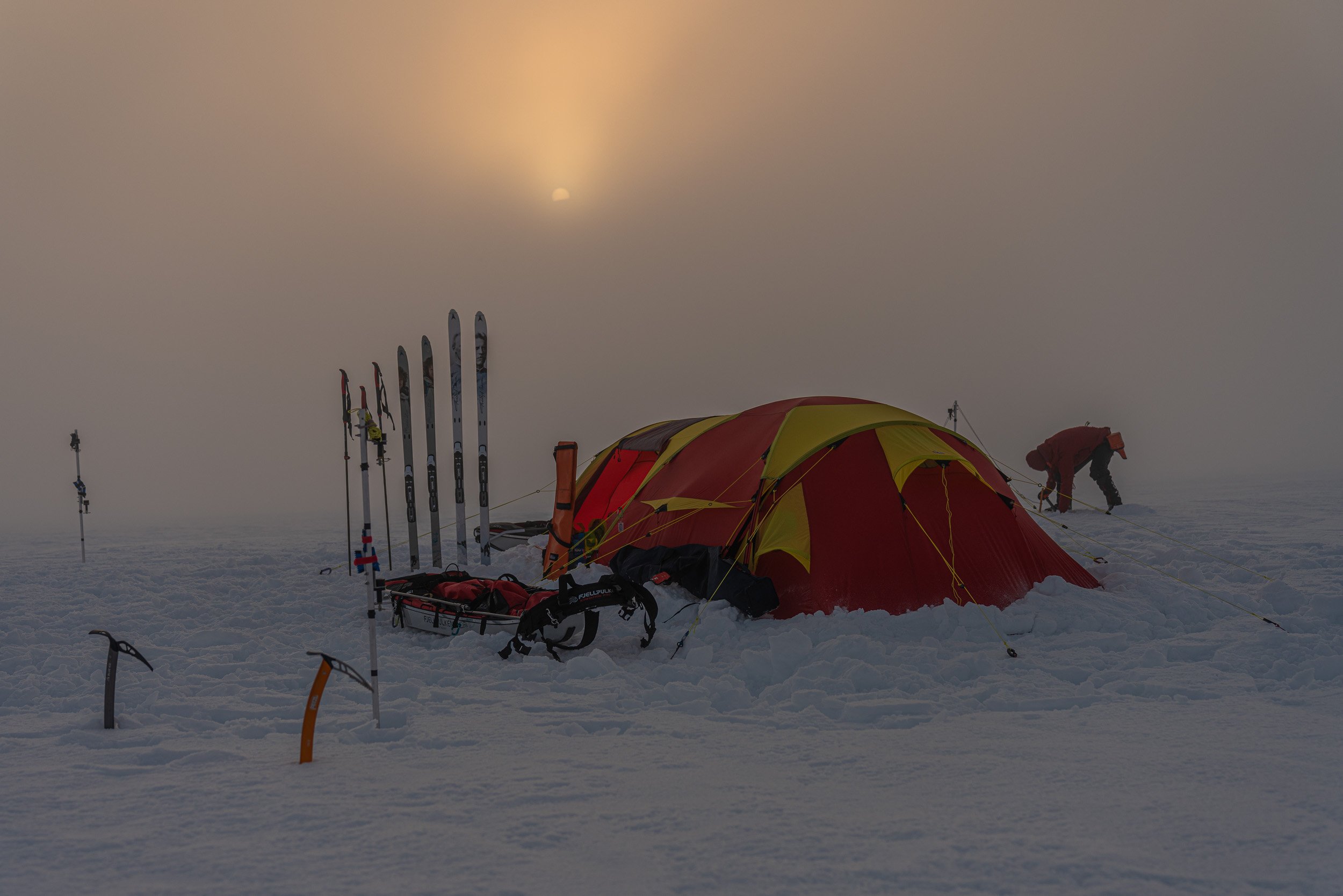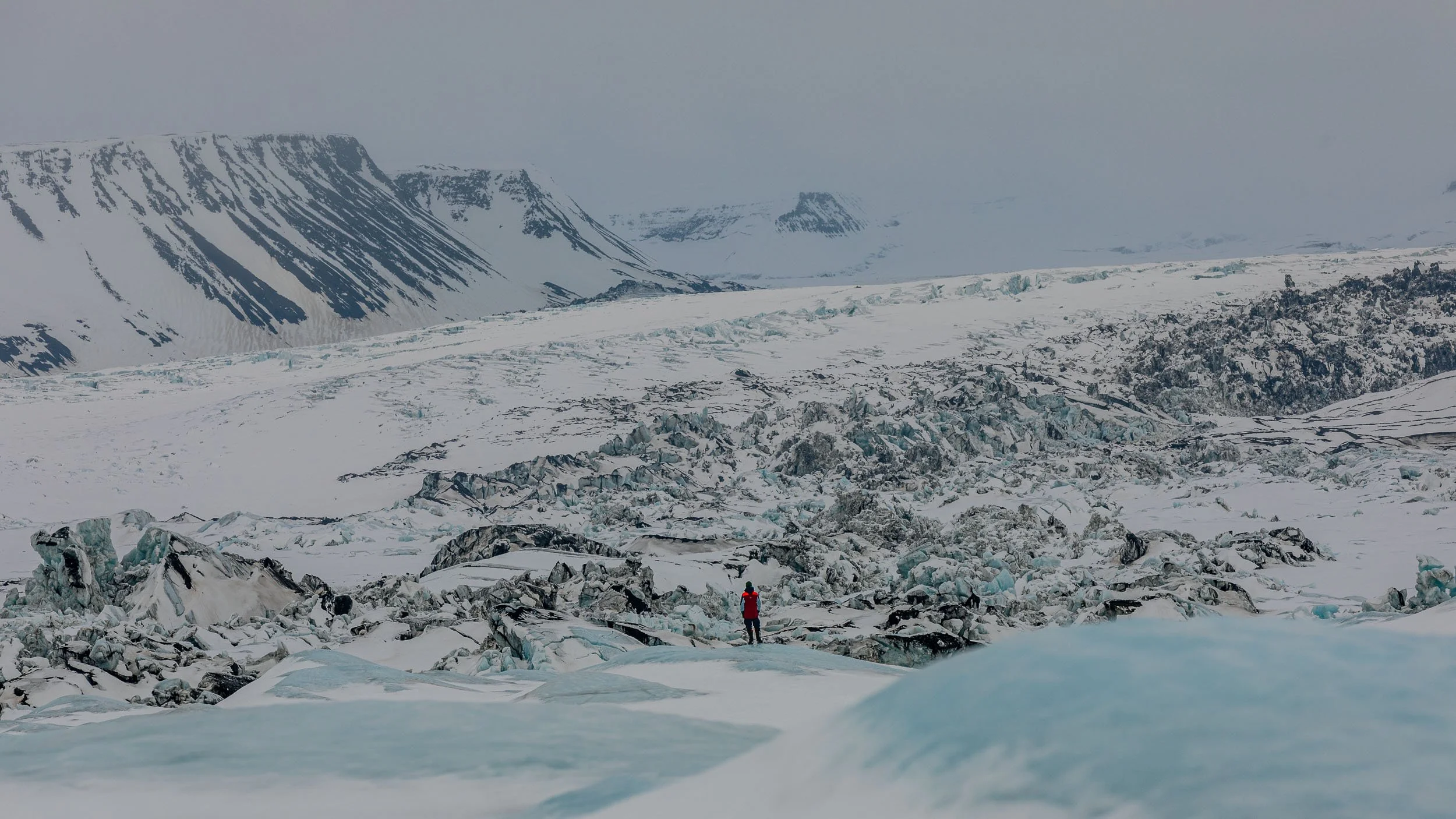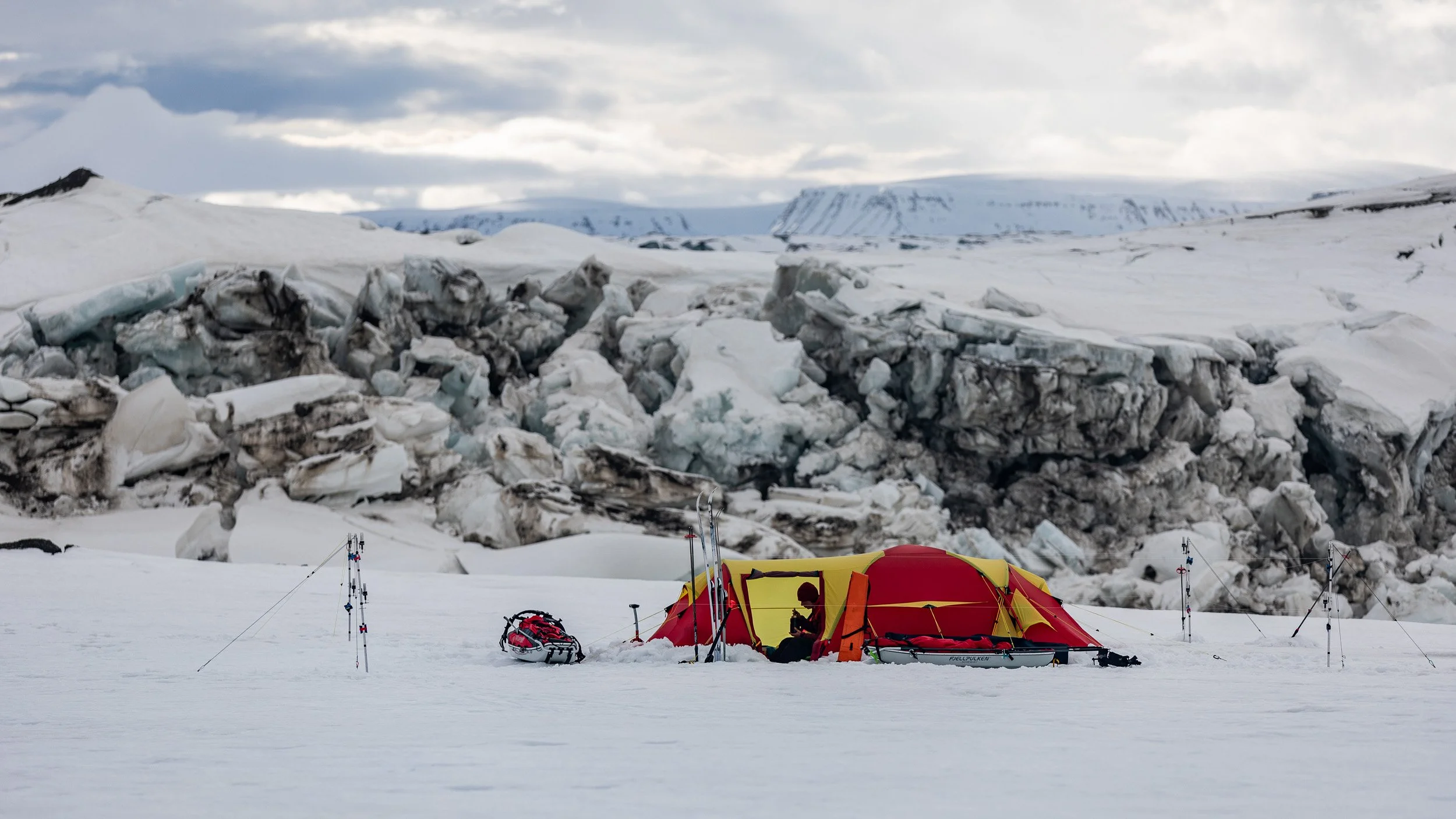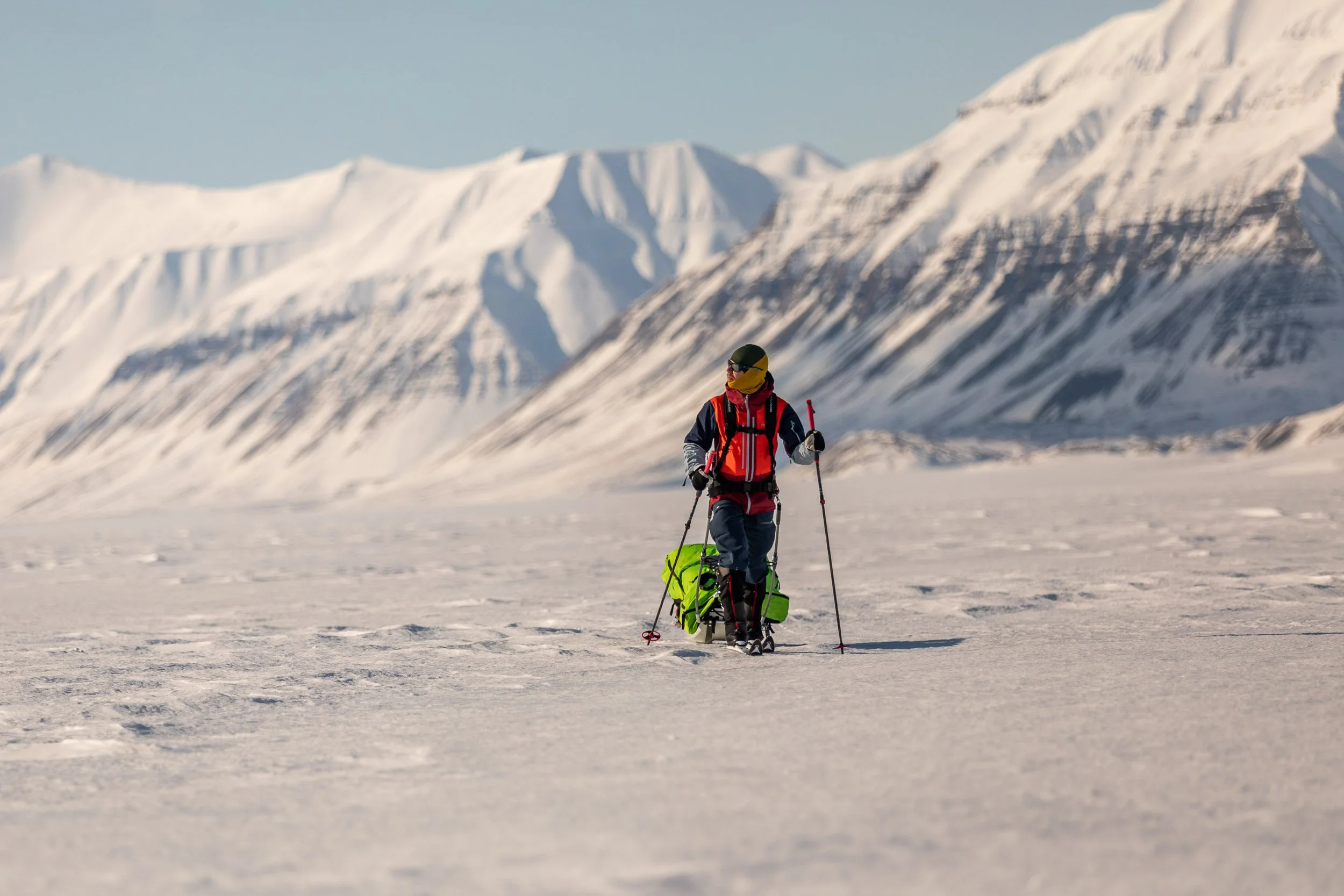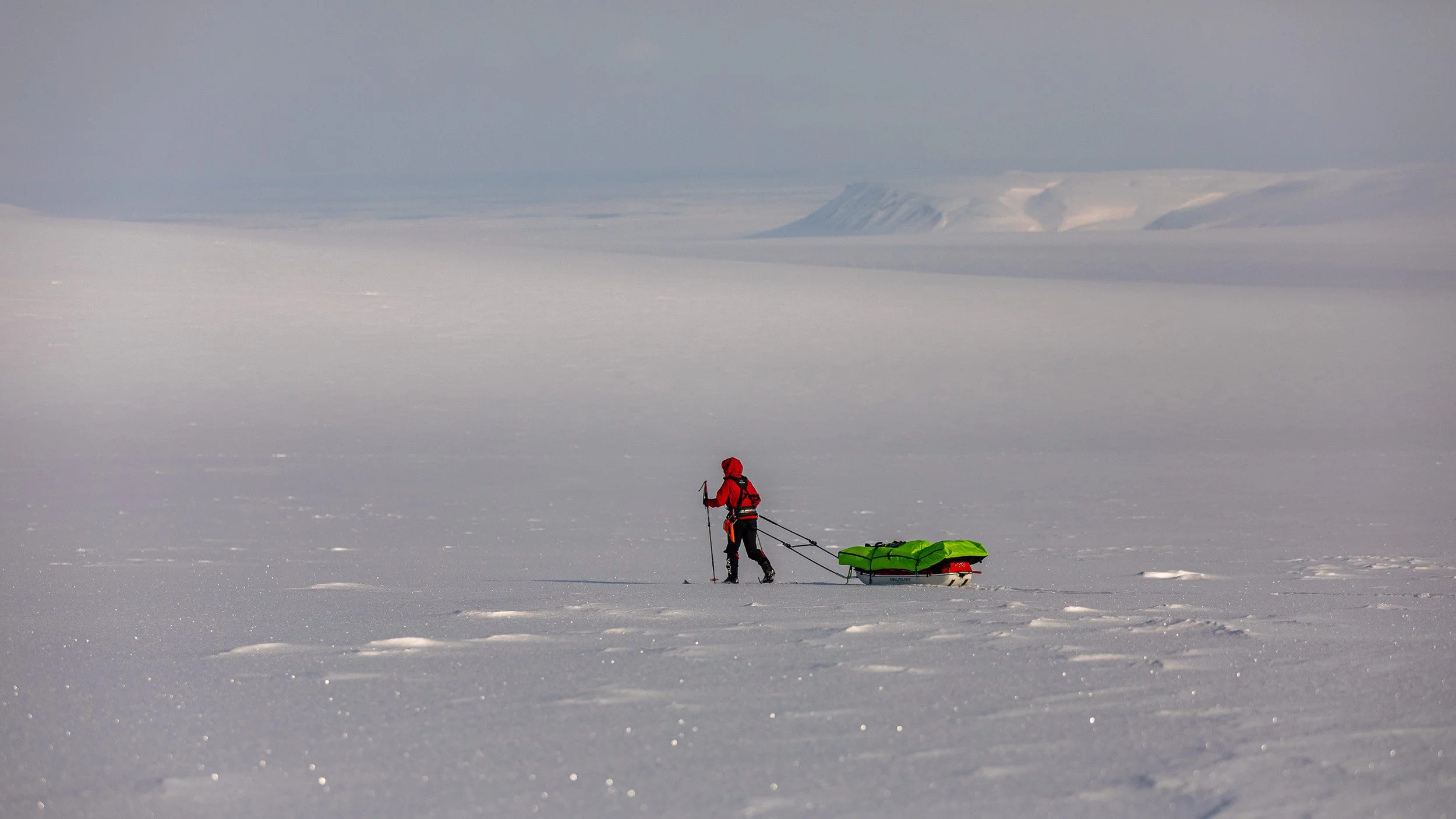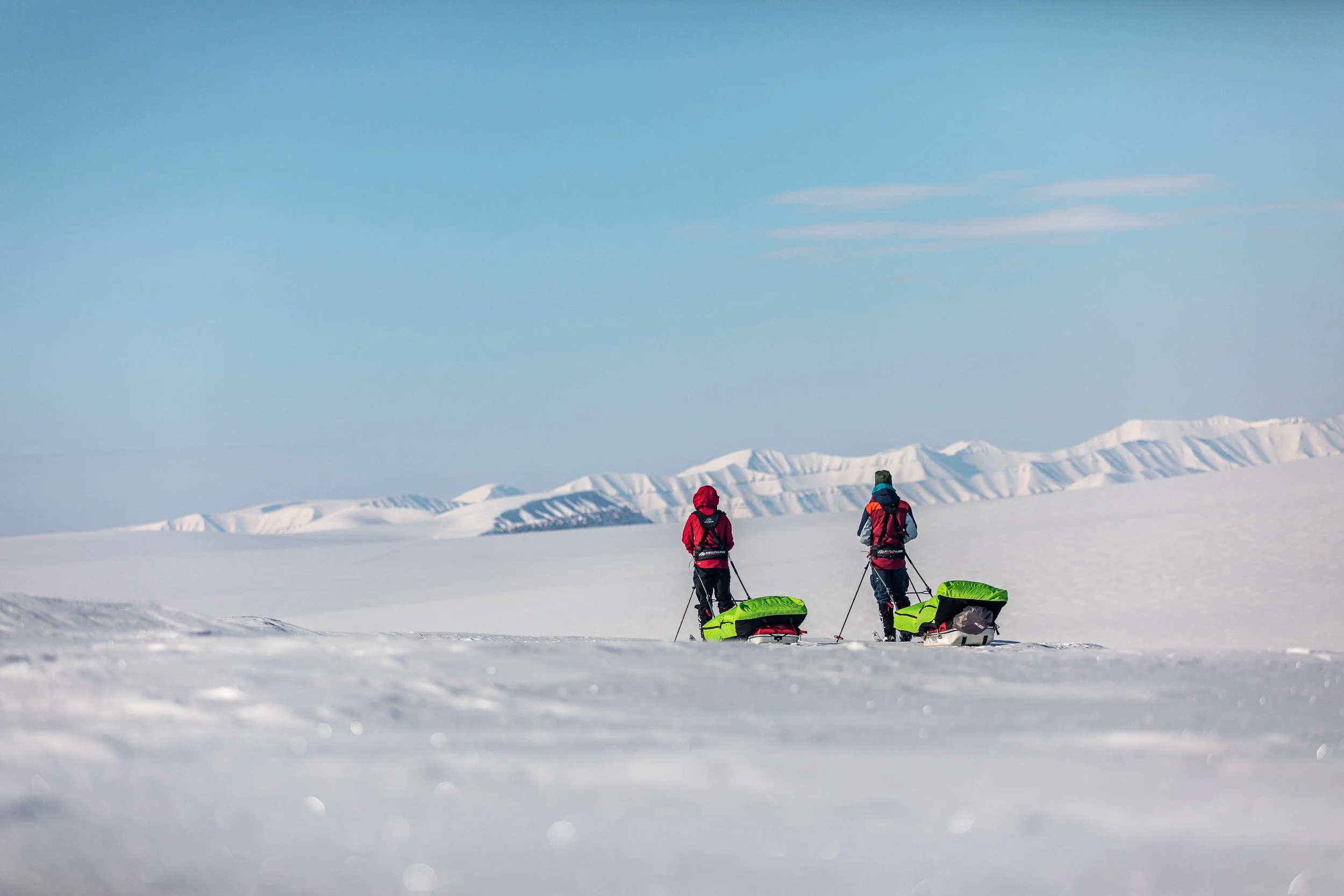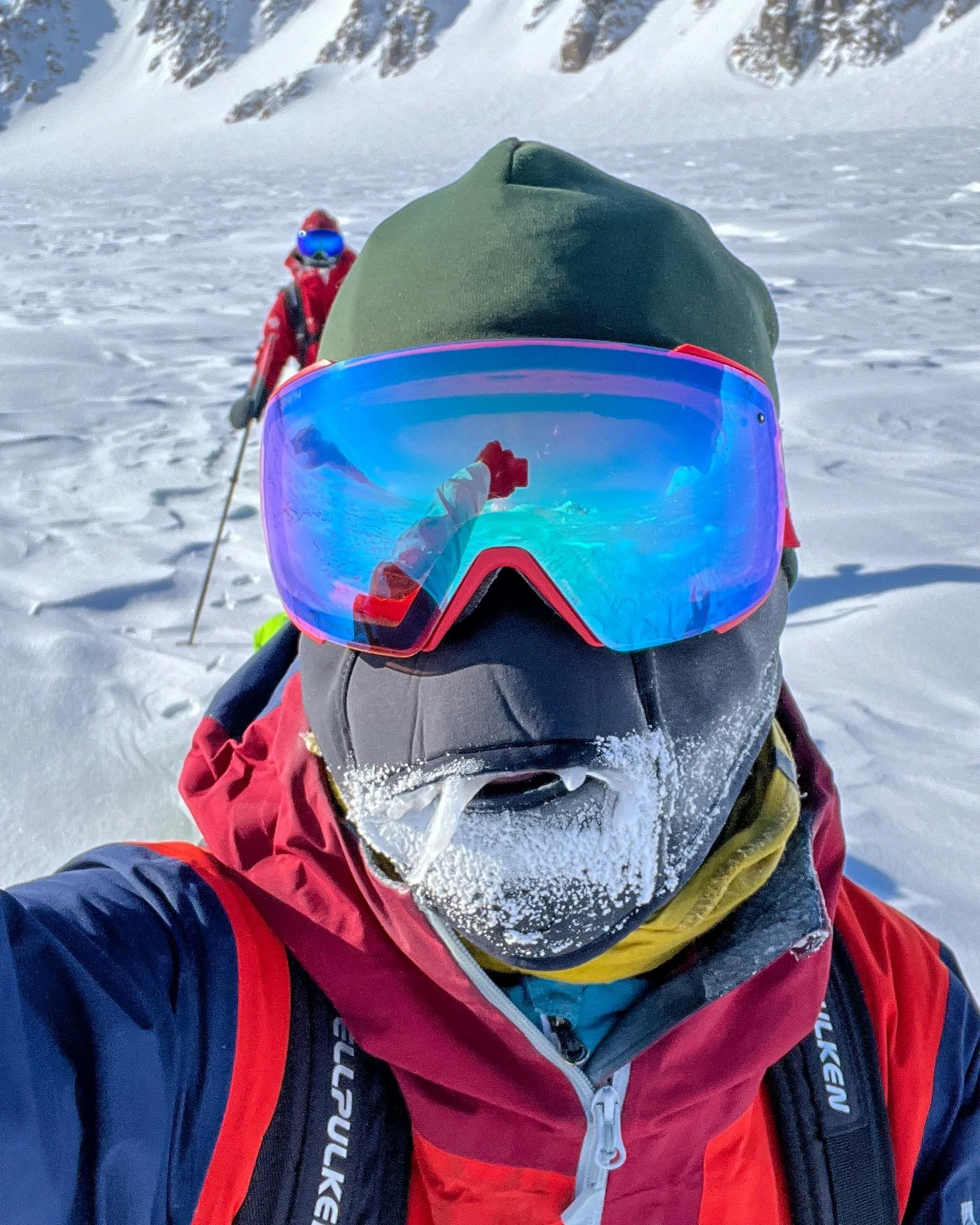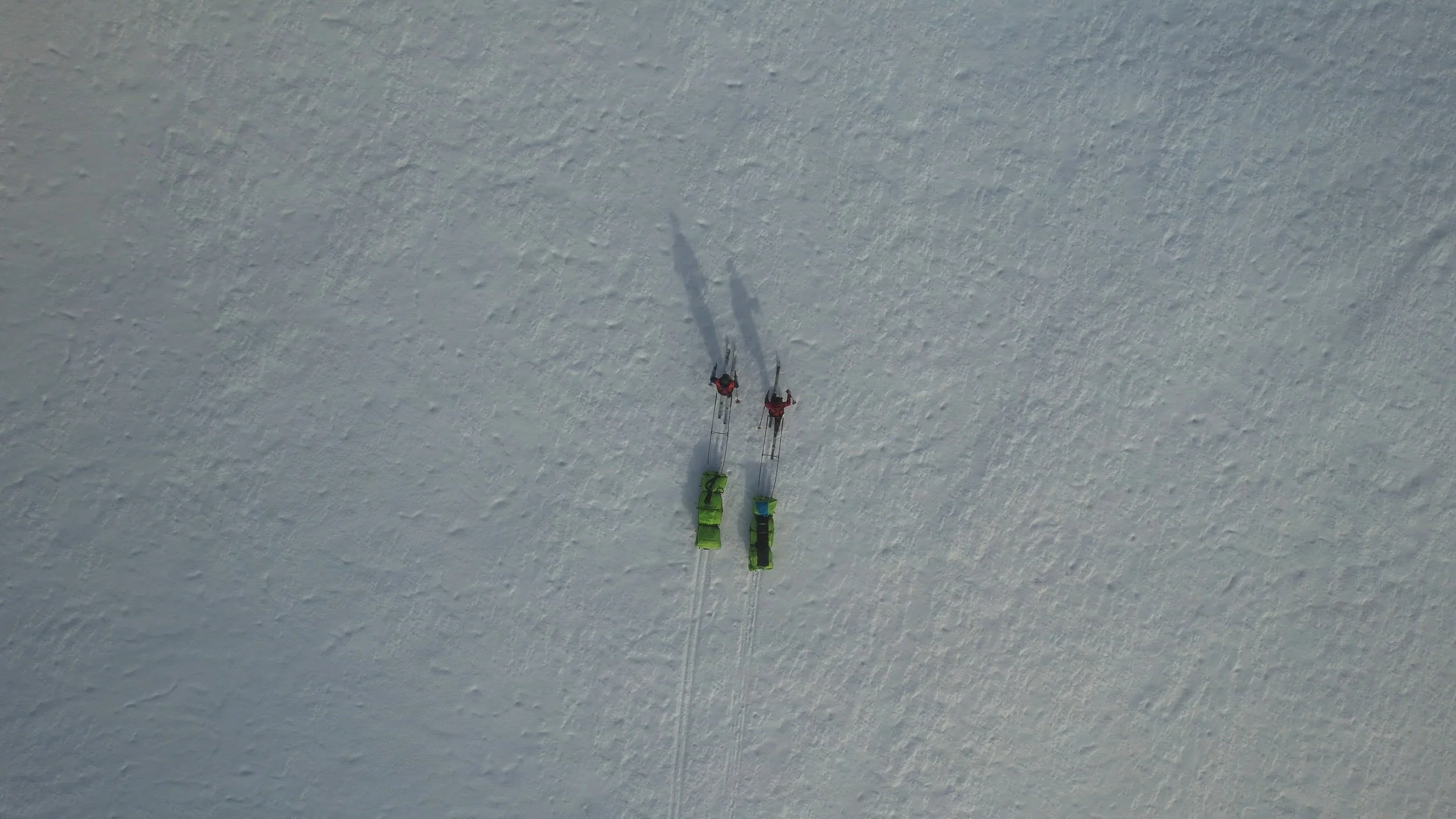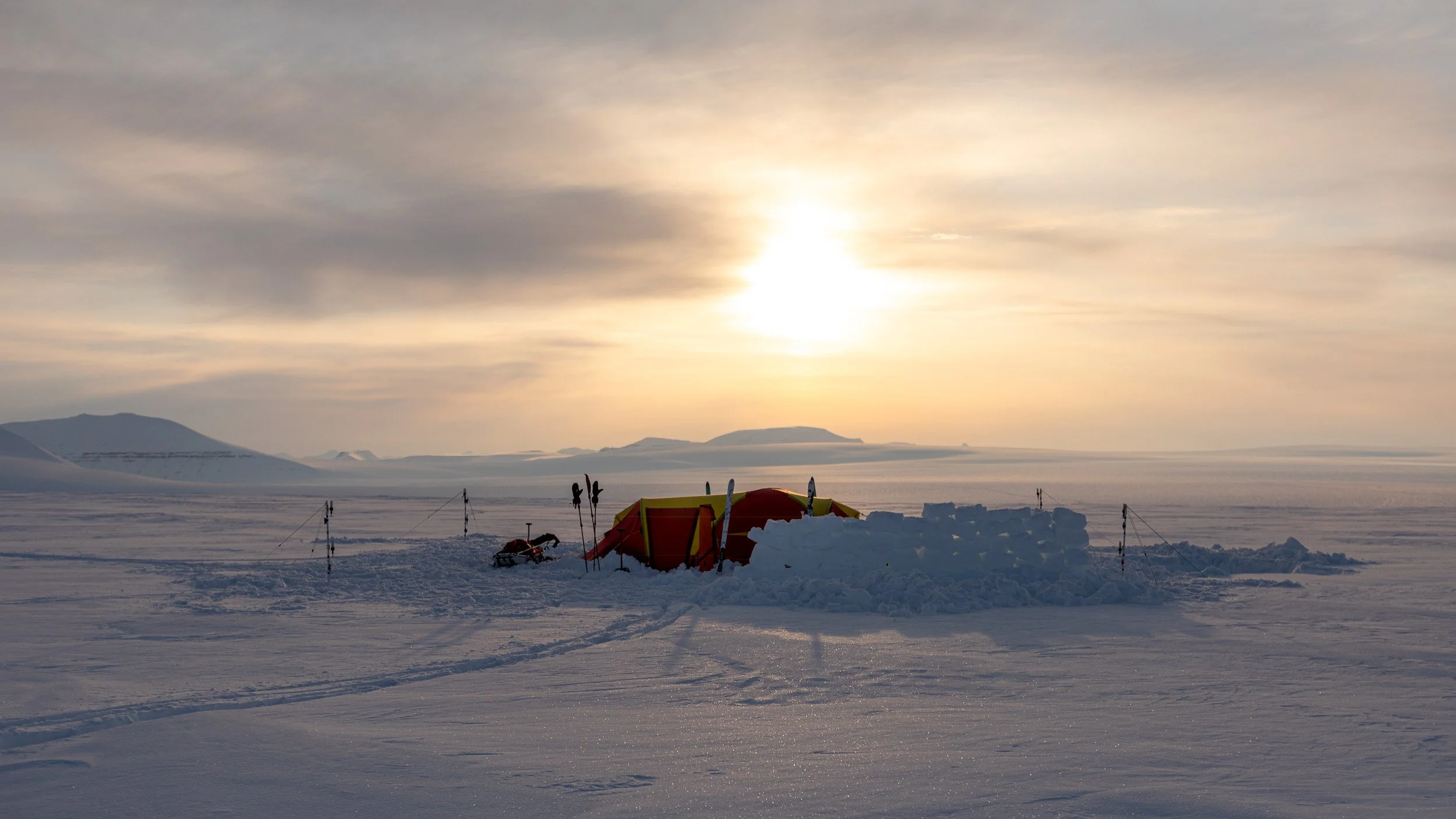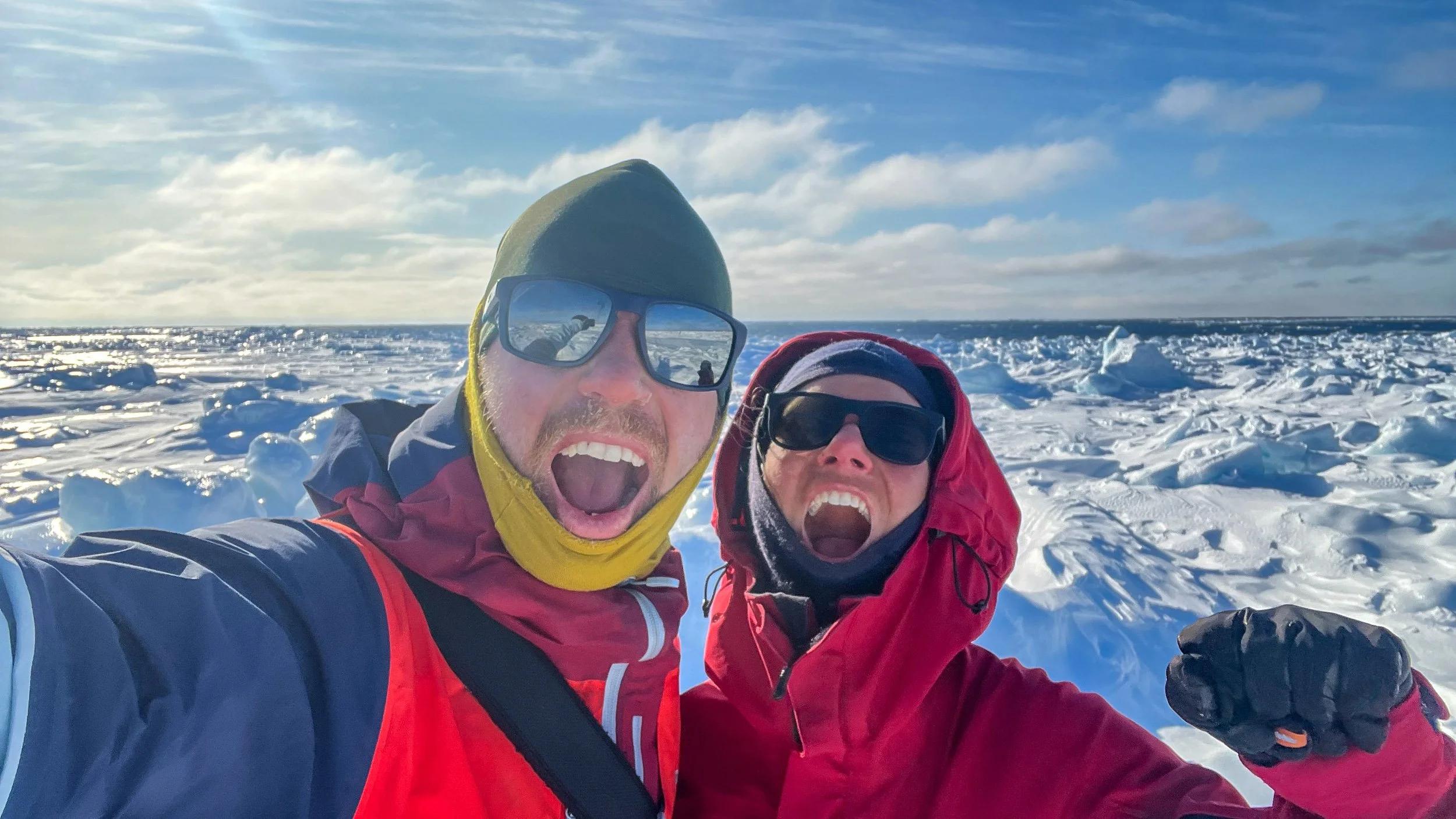SVALBARD PÅ LANGS - SVALBARD, NORWAY - 2023
The story about our crossing of Svalbard on skies in April and May 2023.
The first week of Svalbard På Langs was one continuous exercise in how to manage when things do not go according to plan.
As the southernmost part of the island is a national park, where snowmobiles are not allowed, the drop off point and starting point for our expedition was about 120km north of Sørneset, and the first part would be to go down to the southern tip. But just when the snowmobile team was about to take of, we realized that the tripwire system (for polar bear protection) had been missed when the sledges were loaded in Longyearbyen:( Nothing else to do than to wait for 7 hours while the snowmobile team drove back to get it. So, the first day we covered one kilometer - in the wrong direction.
On the following days, we either had heavy snowfall, headwind and whiteout, or very cold days with lots of fresh snow. And, as icing on the cake, a full day of rain. Combine this with more or less constant uphill along a huge glacier, and a rather heavy pulk full with food and fuel, and we simply got nowhere! After 6 days, we had covered 40km(!) and the frustration was enormous at this point, bordering on resignation.
But on the seventh day we finally caught a break! With colder temperatures the wet snow froze, making the surface hard and fast, and with a clear blue sky and little wind we could relatively effortlessly cover over 60km in just two days, including crossing the sea ice in Isbukta (for which we needed good weather). Still nowhere near the plan, but we were on a roll!
On the 9th day of Svalbard På Langs, the shit hit the fan.
When talking to experienced locals before the start of the expedition, they were very clear on one thing; the ones that need to be rescued are the ones that push too hard towards their goals. After 2 good days we were now suddenly somehow in reach of catching up to our original plan, with hopes of completing the expedition - thus reaching our goal.
Knowing there was a storm coming in the afternoon, we set out on what was supposed to be a short day. After about 4 hours in strong winds and complete whiteout we arrived at the mountain range were we would find shelter from the westerly winds. Problem is, there was no shelter to be found and the terrain was much steeper than we had anticipated from our 1:100.000 maps. Howling downwinds now whirled down the glacier, increasing in strength.
After a problematic search for the flattest and least windy spot around, and after building a solid wind wall, we finally decided it was doable to pitch the tent. But when we were almost finished, one of the strongest gusts we ever experienced hit the tent from the side and simply ripped most of it of the ground. During the handful of seconds before we could both throw ourselves onto the tent and wrestle it to the ground we thought for sure that it would take off and fly out to see.
Once the tent was securely back in its bag, the project of digging a snow cave took us another 3-4 hours, and once safely settled into our sleeping bags the day had been everything but short and we were quite exhausted. With 200km to the nearest civilization and 110km to the border of the national park, we knew that the following day could go two ways; either we would be able to repair the tent and continue the trip, or we would need to call for rescue. Luckily, the following day offered clear and calm weather, and to our great relief and joy, we were actually able to sew some straps back on and replace the broken guy lines and pole segments on the tent with spare parts.
On the following day we were stuck due to fog/whiteout, making us unable to descend the now polished and icy glacier. At this point we were starting to run low on food, and we knew that we had to turn back north on the next day, regardless of if we had reached the southern tip or not. But things break our way in the very last minute and the weather clears in the morning. We felt equally happy and grateful when we reached Sørneset on the 12th day of the expedition, regardless of how far behind the plan we were.
It should be noted that our incident in the storm and the broken tent could, in hindsight, easily have been avoided at several points had we taken more conservative decisions. We did have both the competence and information needed to do so, but yet we got tunnel vision by our desire to reach our goals. Our lives were never in danger, but we did risk the whole expedition – something we had promised ourselves more than once that we would never do...
Heading north from Sørneset, we again had to cross the sea ice on Isbukta. Straightforward the first part, as the storm had leveled the surface a bit and thus less ice structures to get stuck in, but with about 5km to the shore the ice cap was cracked. After an attempt to continue out on the first couple of ice floes, it quickly became clear that this was not the way to go. Instead the only viable option was to follow the edge of the solid ice towards land, hoping it would be possible to find a way onto the shore next to the huge glacierfront that covered the shoreline. Safe to say that it was one of the nicest moments of the expedition when we realized that a 50 meter wide stretch of ice was still left to take us to shore! After a few tricky kilometers along the shoreline we finally made it up the intended glacier late in the evening, rewarded with fantastic views and light during one of the last sunsets before the midnight sun would take over.
With a hard surface on the glaciers and continued nice weather we covered good distances on the following days and even though it was physically challenging we could relax mentally more and more the closer we got to our food depot and national park border back at the drop off point. The last part down the enormous Nathorstbreen and the high-speed-surgeing Liestølbreen was nothing but spectacular, navigating through everything from smooth blue ice to ice structures tall as larger houses. On the 16th day we reached the food depot, having spent 11,5 days going south and 4,5 days going back up north...
After reloading the pulks with food and fuel to get us through the rest of the expedition, we continued northbound. In comparisson to the first part of the trip the next days felt somehow uneventful; crossing another glacier, another passage over sea ice in Van Mijenfjorden and passing by the old mine in Sveagruva before entering the vast valley Kjellströmdalen – a nice contrast to the glaciers and sea ice. At this point we estimated that we had done roughly half the total distance if we were to reach the northern tip, but having used 20 out of the planned 35 days.
The passage between Kjellströmdalen and Sir Martindalen looked a bit tricky on the map, but as there were snowmobile tracks heading up there, we thought that it shouldn't be too hard with skis and pulks. Very naive! It turns out that those snowmobiles can easily go up rather steep terrain, and we had to unload our pulks and make several trips up and down with two people on one pulk. To top it off, the route into the next valley was too steep to ski in the hard and wind affected conditions and we had to walk down a decent part of the valley. The good thing is that we had gotten confirmation to postpone pick up by 3 days, making the plan to reach the northern tip more realistic again.
Entering the northern part of the island, a new type of landscape awaited, with high altitude plateaus of huge and relatively flat glaciers (fonna). The kind of glaciers where you can ski towards a different-shades-of-white horizon the complete day, without any kind of change in scenery. Going up there the feeling of vastness hits you hard, and at the same time the feeling of scale gets completely lost. From our journal on the first day up high: «ALL is white up here, glittering in 5cm of the finest powder. Distances ungraspable. Not scared, but constantly and intensely aware of the remoteness and exposure.»
With sunny weather and fair conditions we had some nice days crossing over Nordmannsfonna and Rabotbreen and some nights with spectacular light from camps high up, looking down over big valleys and fjords, before it was time to cross the 50 km long plateau over Lomonosovfonna. Heavy snow was forecasted two nights later, so while following good scooter tracks we tried do some extra long days before the snowfall – which turned out to be quite the chess move! Because once the snow started to fall it didn't stop for 30 hours, and after a weather day in the tent we found ourselves with 30-40cm of fresh, fluffy snow.
Slowed down significantly by the fresh snow, a long day now meant that we could progress about 15km instead of 20-30km the previous days. And to make it all worse the temperatures dropped to around -30 degrees C, not only making it hard to relax and take breaks during the day, but also making the friction between the snow and the pulks higher. Despite mostly downhill the following days, it felt like one long, tough and constant uphill and progress was extremely slow. With only 5 days left until pick up, we still had an estimated 117km to go. Once again, the hope of finishing was hanging in a thin tread.
Desperate times call for desperate measures.
With temperatures back up to a comfortable -10 degrees C and after a good night's sleep, one last plan to reach the northern tip starts to form – dump everything that is not truly essential for the last 4 days to reduce the weight of the pulks (to be picked up by the snowmobiles on the way back).
Said and done, and encouraged by the easier progress we started the 600m climb up to Åsgardfonna for the last, hopefully, 110km. After two monotonous days with limited visibility up high, we had managed to cover almost half the remaining distance, leaving approximately 60km for the two final days. Despite one of us being physically exhausted and one having bloody and very painful chafings on the heals at that point, all we could think of was to go on and reach the goal.
Then came the day that just wouldn't end. The route down from Åsgardfonna to the coastline, with a 1000m steady and continuous descent, seemed like a simple enough task and some tailwind gave us good progress in the start. But the further down the valley we came the more the wind increased, and once almost down on sea level the winds were so strong that it was difficult both to remain standing and to avoid being, literally, blown away over the partly polished and icy glacier. With absolutely no chance of finding a sheltered camp spot anywhere in the valley, and with southerly winds, the best option was simply to keep going north even though the day had already been long.
It took almost 5 more hours before we could find a small mountain ridge that provided some shelter from the wind. Once there, the bindings on the skis had frozen solid from all the windblown snow during the day and we spent another hour just to get the skies off. After a couple of hours digging a platform that made the ground even enough and pitching the tent it was two tired but very happy souls that enjoyed a warm meal late in the night. And, the best part, it was only 16km left for the last day!
After a couple of hours of sleep the wind had settled down a bit and we set out for the final stretch along the coastline up to the northern tip. Beside painful chafings (on the verge of throwing up from the pain a couple of times) the day was rather straightforward and the last hours left room for mental preparation before arriving at the goal that so clearly had been on our minds for a long long time. Surely we felt happy upon arrival, but there was actually relatively limited feelings and thoughts at that time.
We went south for a kilometer or so before pitching the tent, and spent the night on polar bear watch as we were just by the coastline, with fresh tracks around. We finished that little snacks we had left and celebrated with the last 40g of chocolate and some highly appreciated chocolate mousse while looking out over an intensely dark blue arctic ocean.
The following morning the snowmobile team arrived to pick us up, and we were properly greeted with big hugs, prosecco and brownies. For the first time in 38 days, someone else took charge and fixed everything – a feeling we appreciated so much more than we had expected.
During the first hours of the snowmobile ride back things started to sink in more and more, and waves of overwhelming feelings came rolling over us to the amount that the eyes watered up in the goggles. Feelings dominated by relief in the start, but turning into true happiness somewhere along the way. To complete the happiness, we finally got to see a polar bear on the ride back. At a safe distance it stood on two legs and watched us skeptically for a while before peacefully strolling of.
We covered over 600km and 9000m of vertical gain during our 38 days of Svalbard På Langs and were on the move more than 250 hours in total.
We learned the hard way that pulks should be turned upside down when rain is expected and how strong and unpredictable glacier downwinds can be.
We skied in polar bear tracks and we camped on top of endless glaciers overlooking true wilderness and the arctic ocean in magical sunset light.
Simply put - when it comes to great experiences, we got our money's worth and then some!
The very last input from our journal: «It has been a true adventure, with every component that comes with that word. Svalbard is a special and spectacular place with nature and landscapes unlike anything we ever experienced before. Its beauty, vastness and wilderness has blown us away from time to time.
But it has also been tough. More so than we could imagine. We have been balancing on the border of what is reasonable and healthy more than once… It is two exhausted bodies, with a couple of medical conditions that need care and attention, that now is back in the comfort and safety of civilization.»
THE TEAM
Aniek Lith
Dutch climber/runner/skier with a weak spot for glacier research.
Grew up underneath sea level but has always been attracted to the mountains. Solid climber with multiple first ascents and rare repeats of long technical routes under the belt - summer and winter. Loves all outdoor adventures that are long and tiring.
Aniek is without doubt the Duracell rabbit in the team. In charge of troop morale :)
Marius Rølland
Norwegian/Swedish allround outdoorsman and photography enthusiast.
From the city and grew up playing all kinds of sports, but more into running, hiking and ski touring these days. Realized the beauty of combining running with wilderness and nature some years ago and ran the complete swedish mountain range in one push.
Marius is the gear expert and planning master in the team. In charge of content creation.


